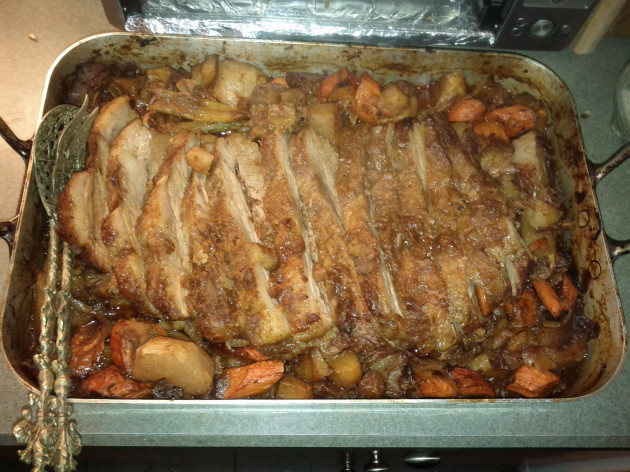
by Amy Stone
May Her Brisket Be for a Blessing
 Grieve. Cook. Bond.
Grieve. Cook. Bond.
By the time my buddy Susan’s father died, the parental East Side Manhattan apartment was getting to look like an assisted living center, housing Susan’s elderly father, mother and aunt, assisted by the team of helpers.
This was the long goodbye to a once powerful man.
Not exactly your traditional Jewess, Susan knew she had moved beyond immediate grief when she turned to Jerusalem A Cookbook. The gorgeously complex recipes of Yotam Ottolenghi and Sami Tamimi are our psalms. Preparation is all consuming and the results must be rejoiced over with friends.
A single Ottolenghi recipe is a major commitment. Three dishes are a triathalon. The recipes: baby spinach salad with dates and almonds, mejadra (lentils with spices) and roasted chicken with lemon and Jerusalem artichoke (forego that last ingredient, unfindable even on the Upper West Side). Susan gathered together buddies who go back to sleep-away camp and Fieldston then Volunteers of America and more recent buddies of the current century. We ate. We drank. We summarized our life stories. And Girls’ Night In was born.
Not exactly the rebirth of the CR (Consciousness Raising) group of the early days of the women’s movement, but close enough. By the time you reach a certain age (say 50 and beyond), you’re interesting, and other women appreciate your life and want to know more, more, more.
Girls’ Night In gathered momentum, advancing into new nooks and crannies. Next time around, we shared the joy of cooking — each of us cooking an Ottolenghi Jerusalem dish. Individual labors of love for each other. In December we broadened the recipe parameters for a Hanukkah-Christmas Middle East Girls’ Night In. Joy, the childhood friend from summer camp, broke from the pack with a beloved brisket recipe. (A Hanukkah tradition in some Ashkenazi households – probably because a good brisket generates enough fat to light several menorahs for the entire eight days.)
Most touching, this was the recipe of Joy’s dear childhood friend’s mother – a recipe from long ago dinners at her friend’s dining room table; a recipe precious enough that Joy got her friend’s mother to write it down for her in her 20s. Forget Proust’s madeleine. Brisket is something we all relate to. This was a rich and wonderful recipe redolent of a bygone era with its call for packaged beef broth and French onion soup mix. As Joy put it, “The recipe’s official title is Jodi’s Mother, Helen Sills’ Clove Brisket. May they both rest in peace and enjoy knowing their cooking legacy lives on.”
Maybe our next Girls’ Night In will be the recipes our mothers scribbled down for us. Recipes from the ‘50s and ‘60s when families stayed home for dinner and, hopefully, dessert was more than canned fruit cocktail embedded in Jello.
Girls’ Night In. We’ve reached the generational point where we can serve up food for our friends on parental china and, condensing decades, jump into new friendships with our friends’ long-time friends. And now, unexpectedly, we’re crossing another frontier — connecting to each other’s loved ones, the ones we can never meet.
May Jodi’s mother, Helen Sills’ clove brisket be for a blessing.
The recipe:
Jodi’s Mother, Helen Sills’ Clove Brisket
Best cooked a day ahead. Freezes well too.
This can be made with or without the cloves.
1st cut brisket. Brisket shrinks quite a lot.
Allow ¾ to 1 lb per person.
5 onions sliced
2-3 turnips cut up in quarters. These will absorb the fat.
3-4 potatoes cut up
6-8 carrots
Some celery
4 packages beef broth. Mix 4 pkgs to 3 cups boiling water
2 pkg dried French onion soup mix
1 cup red wine
Salt
Pepper
Paprika
Cloves
Pierce the brisket every half inch and insert the clove, flower side in.
Put meat in roasting pan with fat side up.
Cover with all ingredients.
Cook at 350 degrees for 3 to 4 hours.
Joy cooked a 5 lb piece for 4 and a half hours.
She says: If undercooked this will be tough. It is hard to overcook this, to a reasonable extent.
Great with potato pancakes!